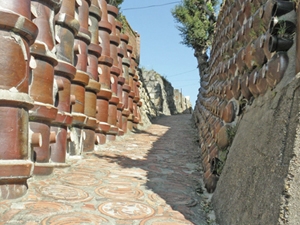
Tokoname was one of the Six Ancient Kilns of Japan, dating back to the Heian Period (794-1185). Pieces of Tokoname-ware, or Tokonome-Yaki as is it is called, dating from this time have been found right across the nation. Tokoname is famous for its teapots, bottles and jars for the carrying of water, sake, and the storage of Buddhist sutras and scrolls, along with tiles, bricks and ceramics. In later years, Tokoname produced roofing tiles, water and sewerage pipes from the red clay. About 60 climbing kilns operated in the town limits, among them, Japan’s biggest, being the Toei Kiln, with eight firing chambers that ran from 1887 until 1974.

Camera enthusiasts descend on Tokoname for the many historical sights, unique to the old town. The area remains somewhat locked in history, dotted with tall, red-brick chimneys in various states of decay dating from the early Meiji (1868-1912) to mid Showa (1936-1989) periods. Old kilns, factories and quaint buildings remain a legacy of the regions once glorious past. Industrialism, and civil engineering needs which had once boosted Tokoname’s coffers changed, and the town went into a decline for many years. Recently, the town has seen a return to prominence and a resurgence in tourists coming to see the trendy, creative pottery shops, galleries, and fashionable cafes.

Start with a walk along the narrow, charm filled backstreets of the ancient pottery town, along the famous Dokan Zaka, a short steep tiled path lined with walls of earthenware pipes and bottles. See the Maneki-Neko street, featuring hundreds of the beckoning cat figures, and the giant mascot cat, Tokonyan. Tour the inside of Japan’s largest climbing kiln, used until 1974. See the INAX Tile Museum, and enjoy shopping in the various pottery galleries and cafes around one of the most creative and ancient towns of Aichi. Walking maps from the Ceramic Hall will open your eyes to a Japan rarely seen.

























 Keyword
Keyword







